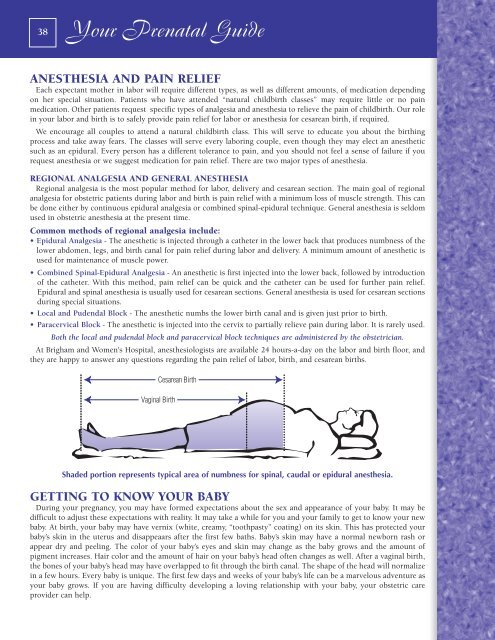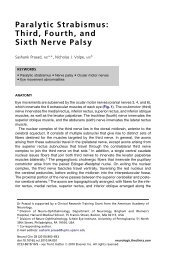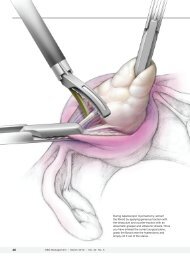Enjoying Your Pregnancy Guide to Understanding - Brigham and ...
Enjoying Your Pregnancy Guide to Understanding - Brigham and ...
Enjoying Your Pregnancy Guide to Understanding - Brigham and ...
You also want an ePaper? Increase the reach of your titles
YUMPU automatically turns print PDFs into web optimized ePapers that Google loves.
38<br />
<strong>Your</strong> Prenatal <strong>Guide</strong><br />
ANESTHESIA AND PAIN RELIEF<br />
Each expectant mother in labor will require different types, as well as different amounts, of medication depending<br />
on her special situation. Patients who have attended “natural childbirth classes” may require little or no pain<br />
medication. Other patients request specific types of analgesia <strong>and</strong> anesthesia <strong>to</strong> relieve the pain of childbirth. Our role<br />
in your labor <strong>and</strong> birth is <strong>to</strong> safely provide pain relief for labor or anesthesia for cesarean birth, if required.<br />
We encourage all couples <strong>to</strong> attend a natural childbirth class. This will serve <strong>to</strong> educate you about the birthing<br />
process <strong>and</strong> take away fears. The classes will serve every laboring couple, even though they may elect an anesthetic<br />
such as an epidural. Every person has a different <strong>to</strong>lerance <strong>to</strong> pain, <strong>and</strong> you should not feel a sense of failure if you<br />
request anesthesia or we suggest medication for pain relief. There are two major types of anesthesia.<br />
REGIONAL ANALGESIA AND GENERAL ANESTHESIA<br />
Regional analgesia is the most popular method for labor, delivery <strong>and</strong> cesarean section. The main goal of regional<br />
analgesia for obstetric patients during labor <strong>and</strong> birth is pain relief with a minimum loss of muscle strength. This can<br />
be done either by continuous epidural analgesia or combined spinal-epidural technique. General anesthesia is seldom<br />
used in obstetric anesthesia at the present time.<br />
Common methods of regional analgesia include:<br />
• Epidural Analgesia - The anesthetic is injected through a catheter in the lower back that produces numbness of the<br />
lower abdomen, legs, <strong>and</strong> birth canal for pain relief during labor <strong>and</strong> delivery. A minimum amount of anesthetic is<br />
used for maintenance of muscle power.<br />
• Combined Spinal-Epidural Analgesia - An anesthetic is first injected in<strong>to</strong> the lower back, followed by introduction<br />
of the catheter. With this method, pain relief can be quick <strong>and</strong> the catheter can be used for further pain relief.<br />
Epidural <strong>and</strong> spinal anesthesia is usually used for cesarean sections. General anesthesia is used for cesarean sections<br />
during special situations.<br />
• Local <strong>and</strong> Pudendal Block - The anesthetic numbs the lower birth canal <strong>and</strong> is given just prior <strong>to</strong> birth.<br />
• Paracervical Block - The anesthetic is injected in<strong>to</strong> the cervix <strong>to</strong> partially relieve pain during labor. It is rarely used.<br />
Both the local <strong>and</strong> pudendal block <strong>and</strong> paracervical block techniques are administered by the obstetrician.<br />
At <strong>Brigham</strong> <strong>and</strong> Women's Hospital, anesthesiologists are available 24 hours-a-day on the labor <strong>and</strong> birth floor, <strong>and</strong><br />
they are happy <strong>to</strong> answer any questions regarding the pain relief of labor, birth, <strong>and</strong> cesarean births.<br />
Shaded portion represents typical area of numbness for spinal, caudal or epidural anesthesia.<br />
GETTING TO KNOW YOUR BABY<br />
During your pregnancy, you may have formed expectations about the sex <strong>and</strong> appearance of your baby. It may be<br />
difficult <strong>to</strong> adjust these expectations with reality. It may take a while for you <strong>and</strong> your family <strong>to</strong> get <strong>to</strong> know your new<br />
baby. At birth, your baby may have vernix (white, creamy, “<strong>to</strong>othpasty” coating) on its skin. This has protected your<br />
baby’s skin in the uterus <strong>and</strong> disappeaars after the first few baths. Baby’s skin may have a normal newborn rash or<br />
appear dry <strong>and</strong> peeling. The color of your baby’s eyes <strong>and</strong> skin may change as the baby grows <strong>and</strong> the amount of<br />
pigment increases. Hair color <strong>and</strong> the amount of hair on your baby’s head often changes as well. After a vaginal birth,<br />
the bones of your baby’s head may have overlapped <strong>to</strong> fit through the birth canal. The shape of the head will normalize<br />
in a few hours. Every baby is unique. The first few days <strong>and</strong> weeks of your baby’s life can be a marvelous adventure as<br />
your baby grows. If you are having difficulty developing a loving relationship with your baby, your obstetric care<br />
provider can help.
















